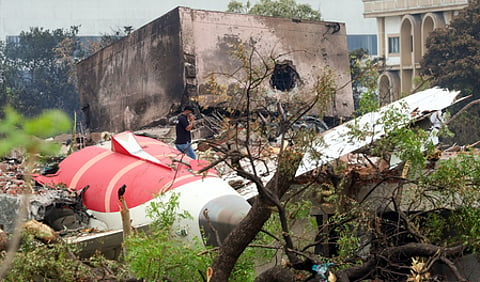‘I didn’t cut off fuel’: Can airline fuel control switches move without pilot intent?
Air India crash report: Cockpit questions ignite reasons beyond possible pilot error

Dubai: When both engine fuel control switches on Air India Flight 171 moved from "RUN" to "CUTOFF" shortly after takeoff, the result was catastrophic.
The engines shut down midair, and the plane crashed within seconds. But the words recorded in the cockpit—“Why did you cut off the fuel?” “I didn’t.”—have ignited a debate far beyond a possible pilot error.
While the final investigation report is still pending, experts and regulators are now asking: Can fuel control switches even move without pilot intent?
Not just a pilot mistake: What else can cause it
Investigators are exploring multiple possibilities—mechanical, electrical, and procedural—suggesting that pilot action may not be the only explanation for what happened in those critical seconds.
1. Locking mechanism disengagement: A known advisory
In 2018, the U.S. Federal Aviation Administration (FAA) issued a Special Airworthiness Information Bulletin (SAIB) highlighting a potential issue with fuel control switch locking mechanisms in certain Boeing aircraft. The Boeing 787-8—the same model as AI 171—was included. The concern? If the lock disengaged, the switches could be toggled more easily, even unintentionally.
Normally, moving these spring-loaded switches requires a deliberate lift-then-shift motion, with physical guard rails preventing accidental activation. If this system failed or was compromised, a sudden dual switch transition could occur—even with no direct input from the crew.
Air India did not act on this advisory, as the FAA note was not mandatory. But its relevance has now resurfaced.
2. Electrical or software malfunction
A second theory under investigation involves electronic or mechanical failure—specifically, a fault in the throttle control module or the engine’s electronic control unit (ECU).
This component governs the behavior of the fuel switches and engine response. A software glitch or microprocessor fault could theoretically command both switches to shift to "CUTOFF" unintentionally.
Notably, cockpit systems did attempt to relight the engines within seconds, suggesting automation kicked in—but the aircraft was already too low to recover.
3. In-flight turbulence or vibration interference?
While pilot involvement hasn't been ruled out, aviation experts note that intense vibrations or turbulence during take-off could, in extremely rare circumstances, interfere with cockpit controls—particularly if the locking mechanism on the fuel switches was already compromised.
This could result in unintended switch movement without deliberate human input. Notably, both switches were later found in the "RUN" position in the wreckage, suggesting the crew attempted to restore engine power—but the aircraft was already too low for recovery.
But can switches really move by accident?
Most pilots say accidental toggling is near-impossible—especially both switches at once. The fuel control switches are protected by stop locks and spring-loaded guards. These are designed to prevent mishandling during flight.
As multiple past advisories—including from the FAA—have warned of “unintended disengagement” of these guards, particularly under vibration, wear, or improper maintenance, while it's rare, it's not impossible.
Until the final report is out, no conclusions can be drawn on what—or who—caused the dual engine shutdown. But what’s clear is that fuel control switch movements can, in rare cases, happen outside of direct pilot control, due to system flaws or overlooked advisories.
The case of AI 171 is now prompting global regulators, airlines, and manufacturers to re-examine long-assumed cockpit safeguards—because when seconds matter, even one unintentional switch movement can turn tragic.
Sign up for the Daily Briefing
Get the latest news and updates straight to your inbox




